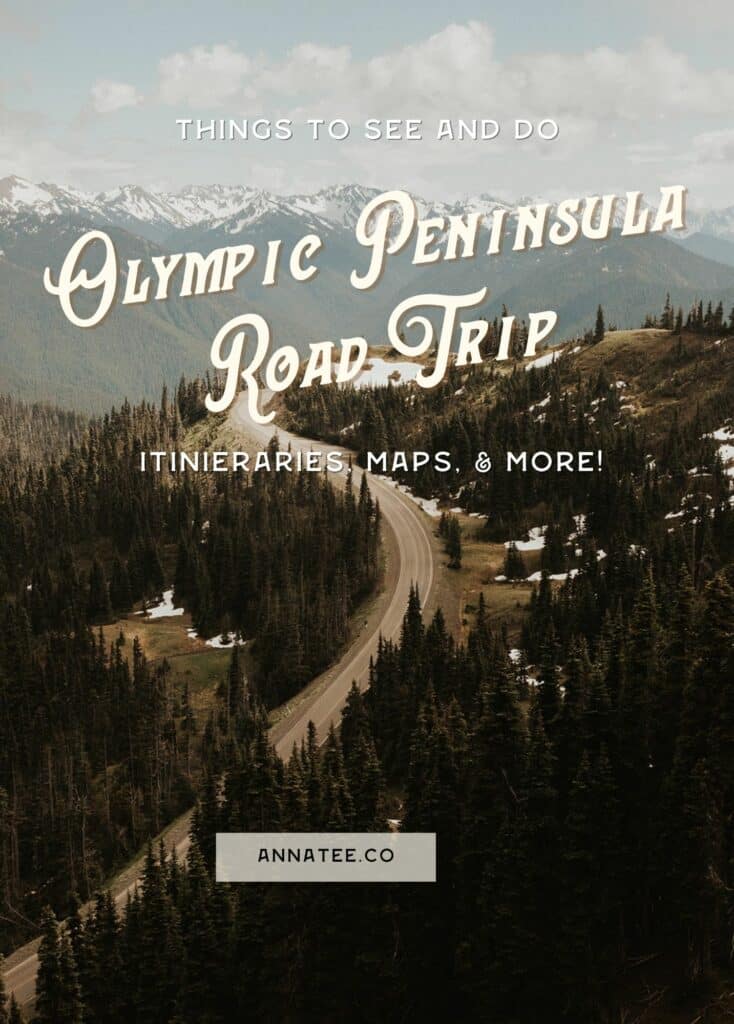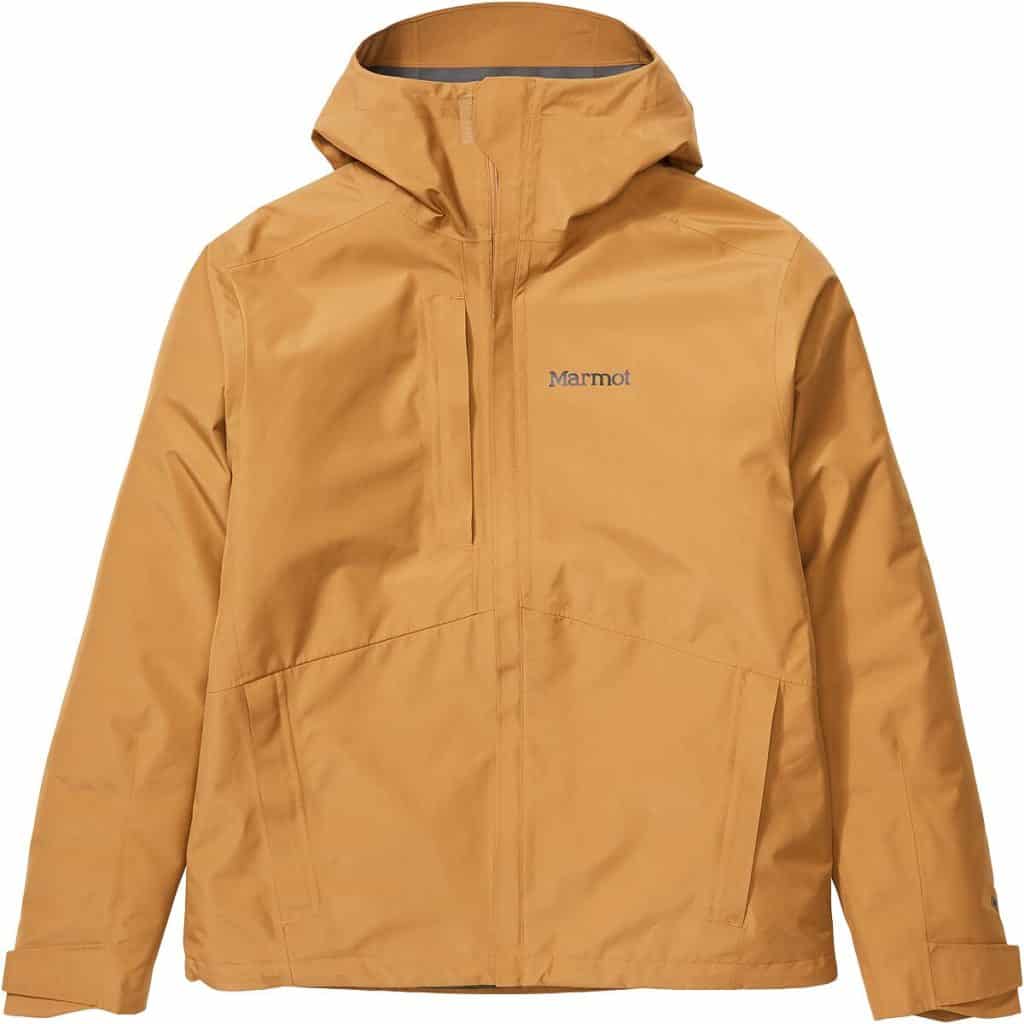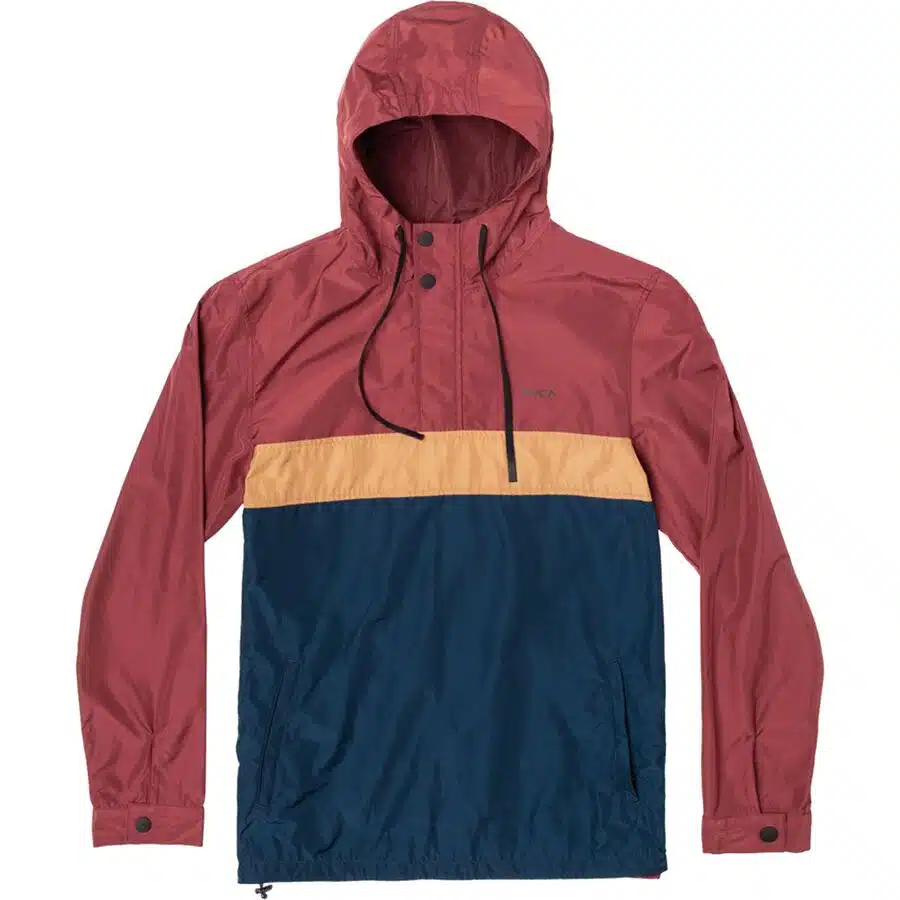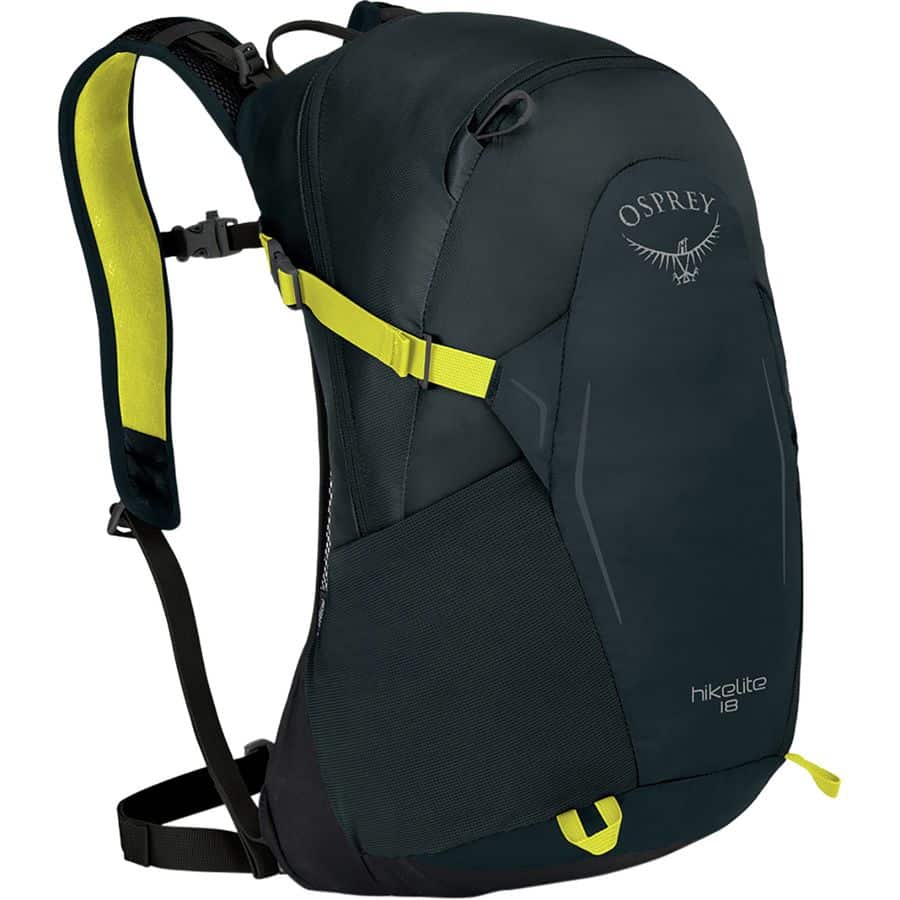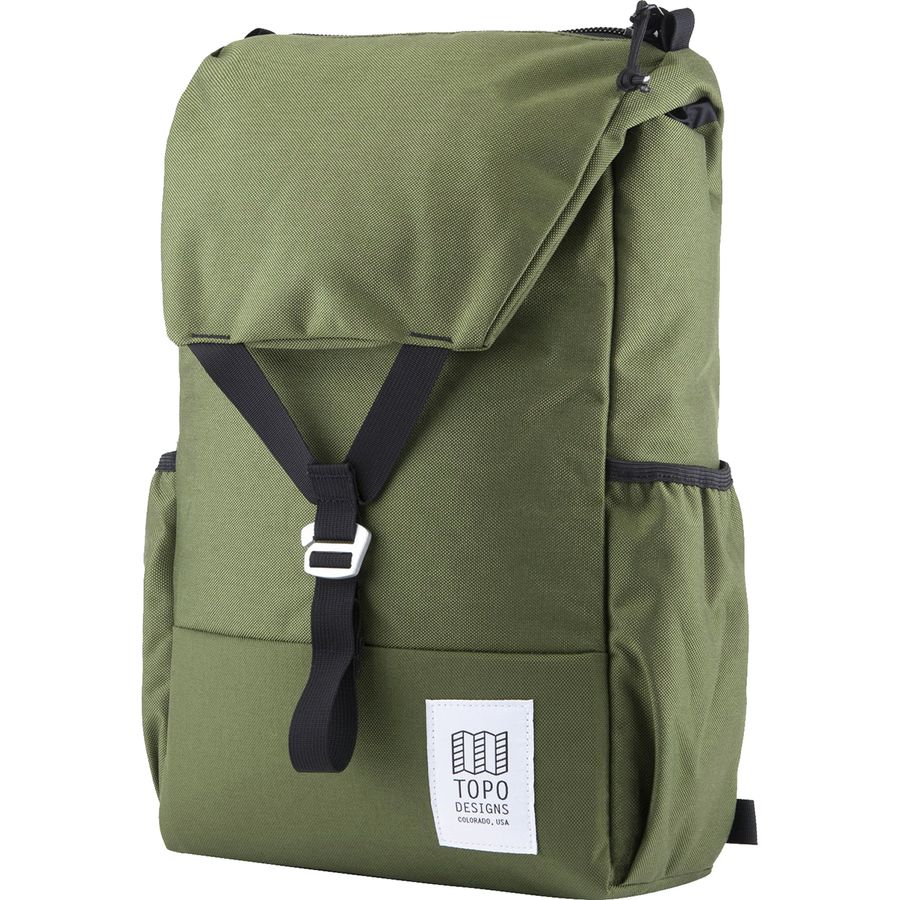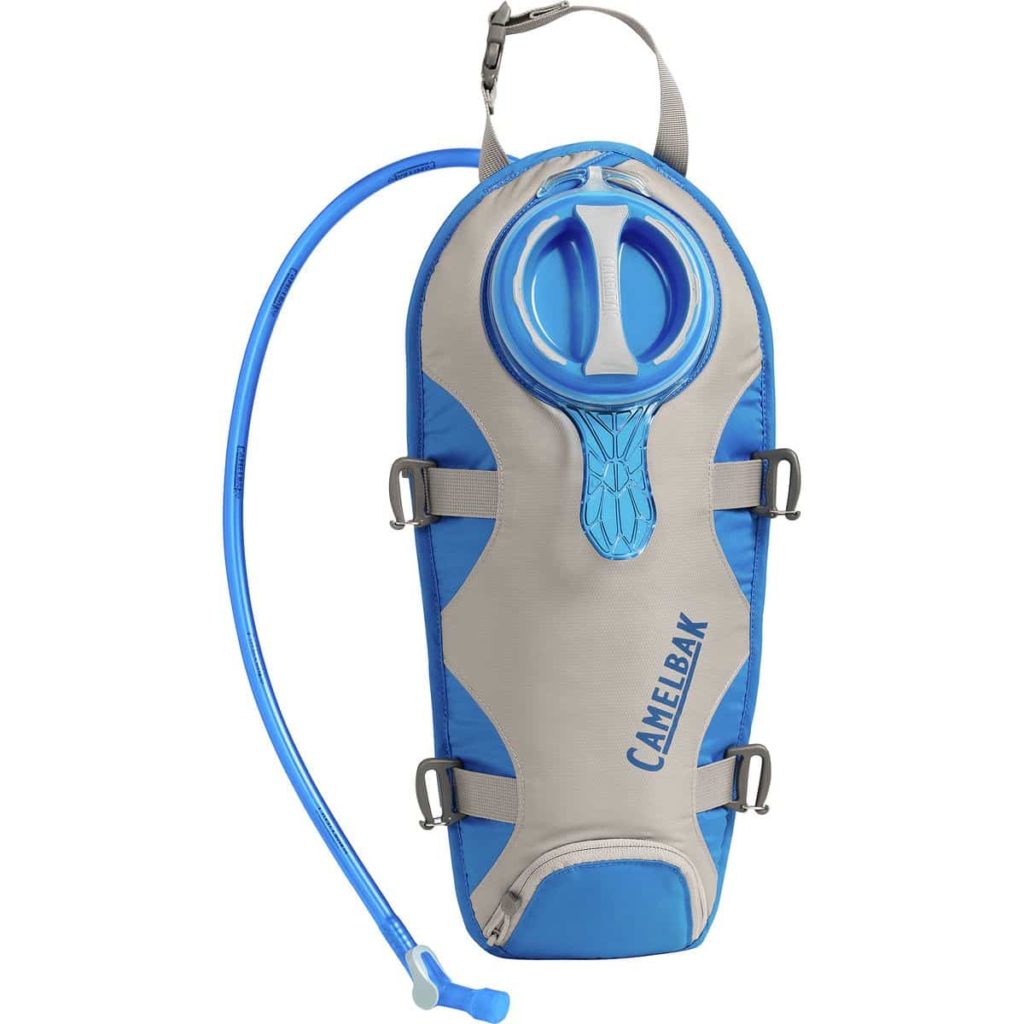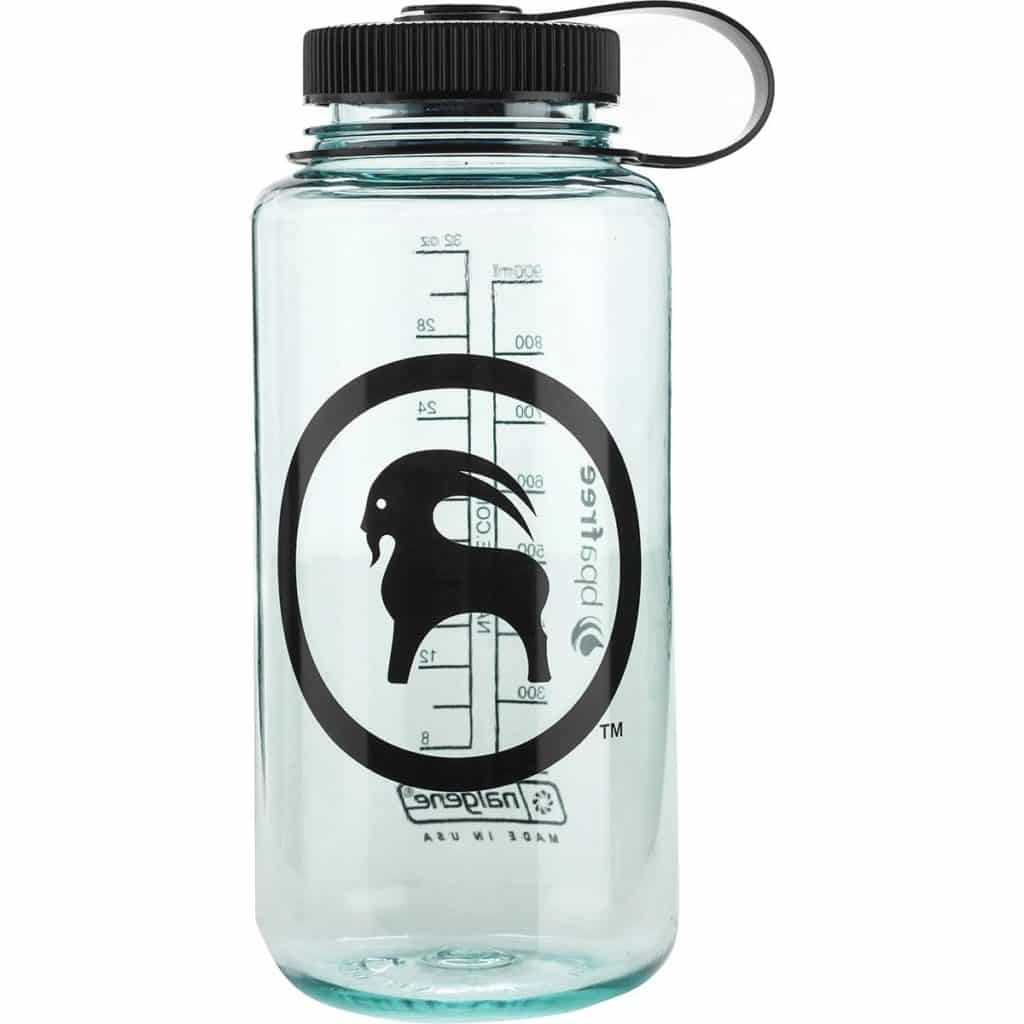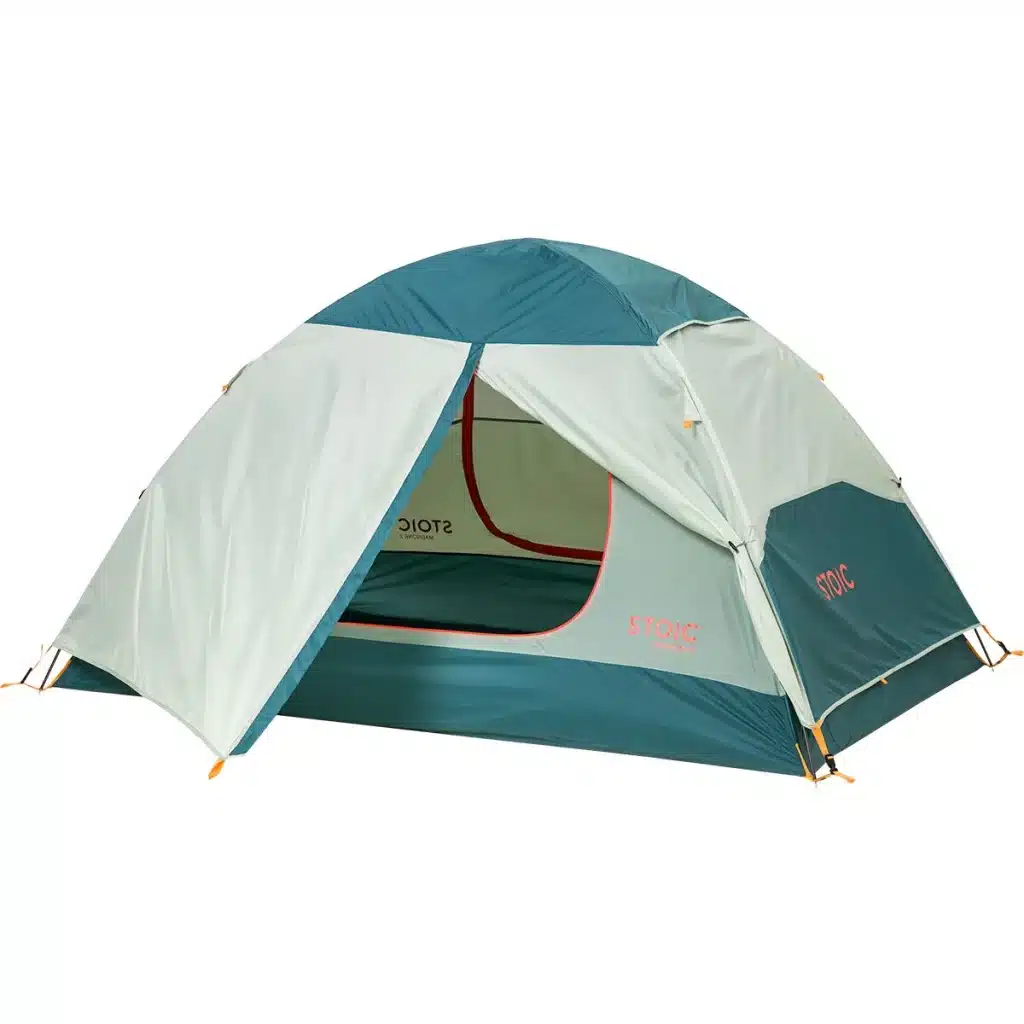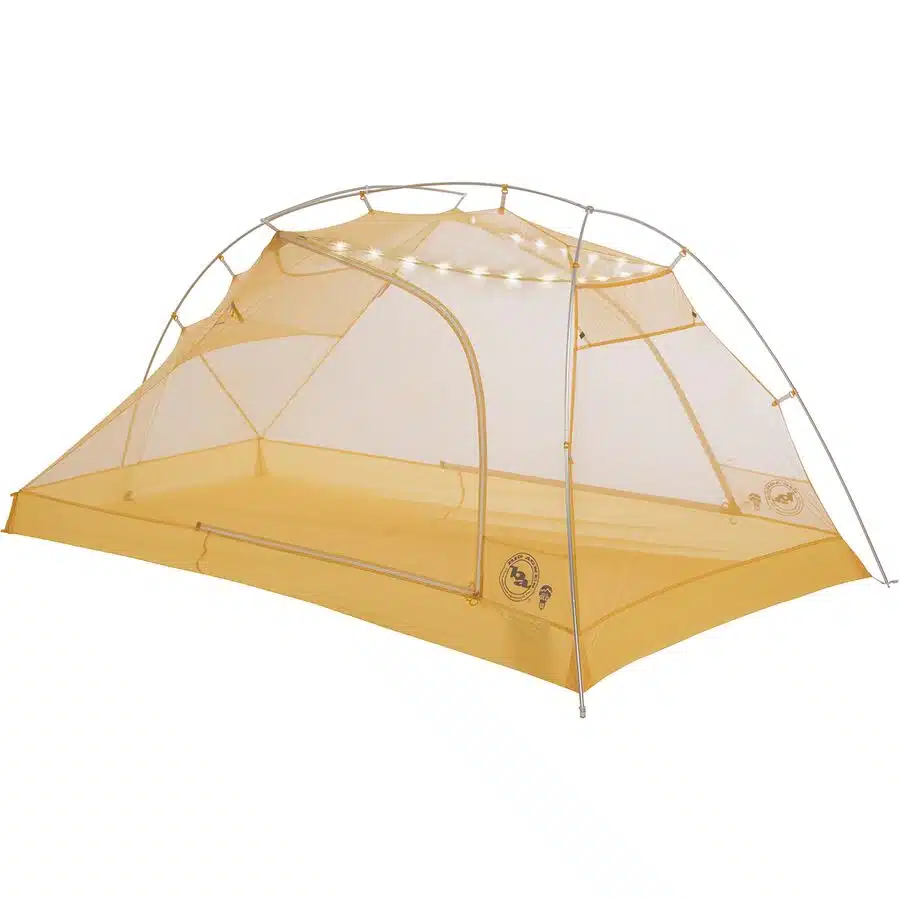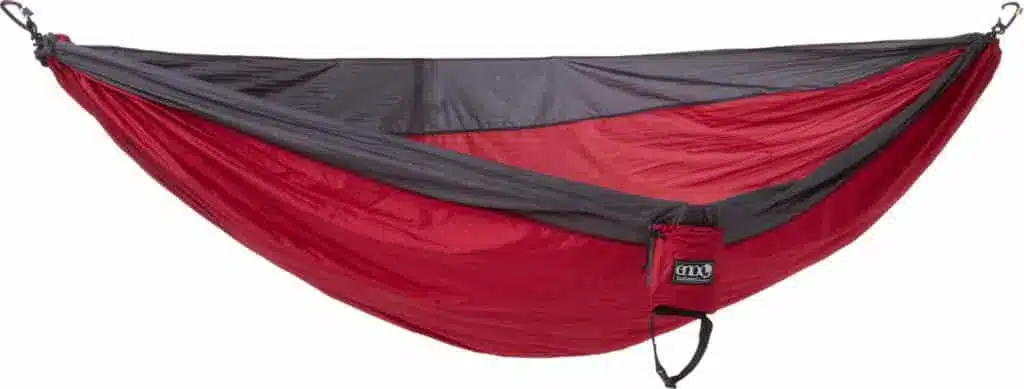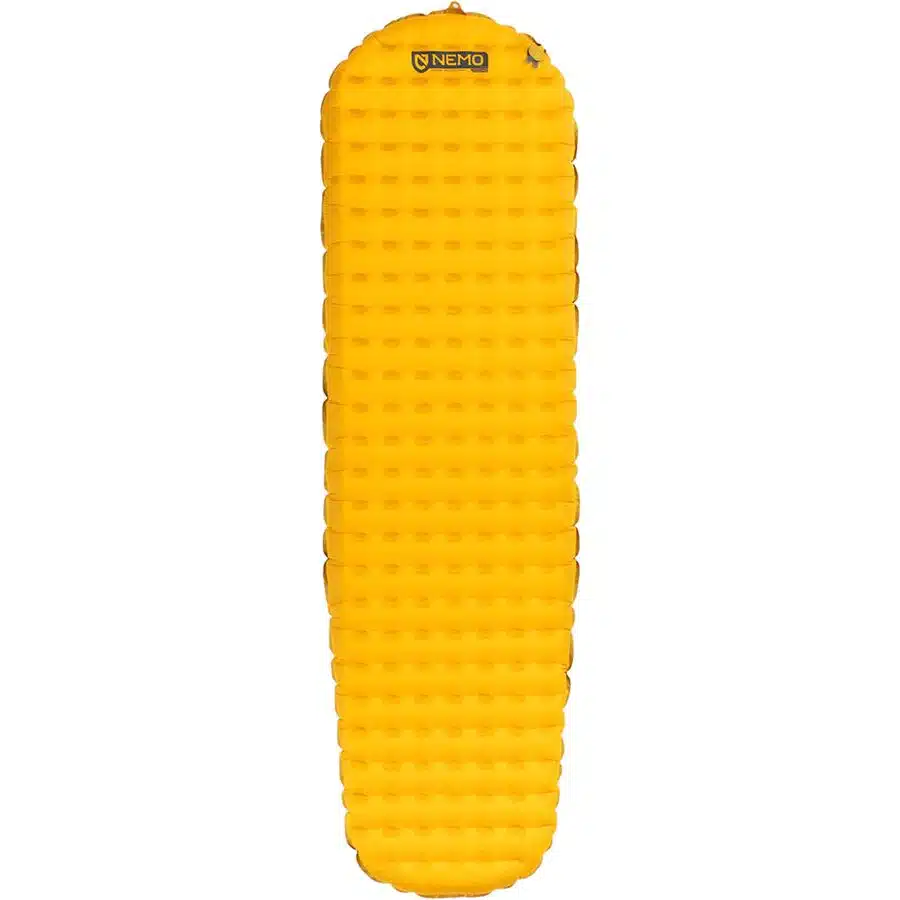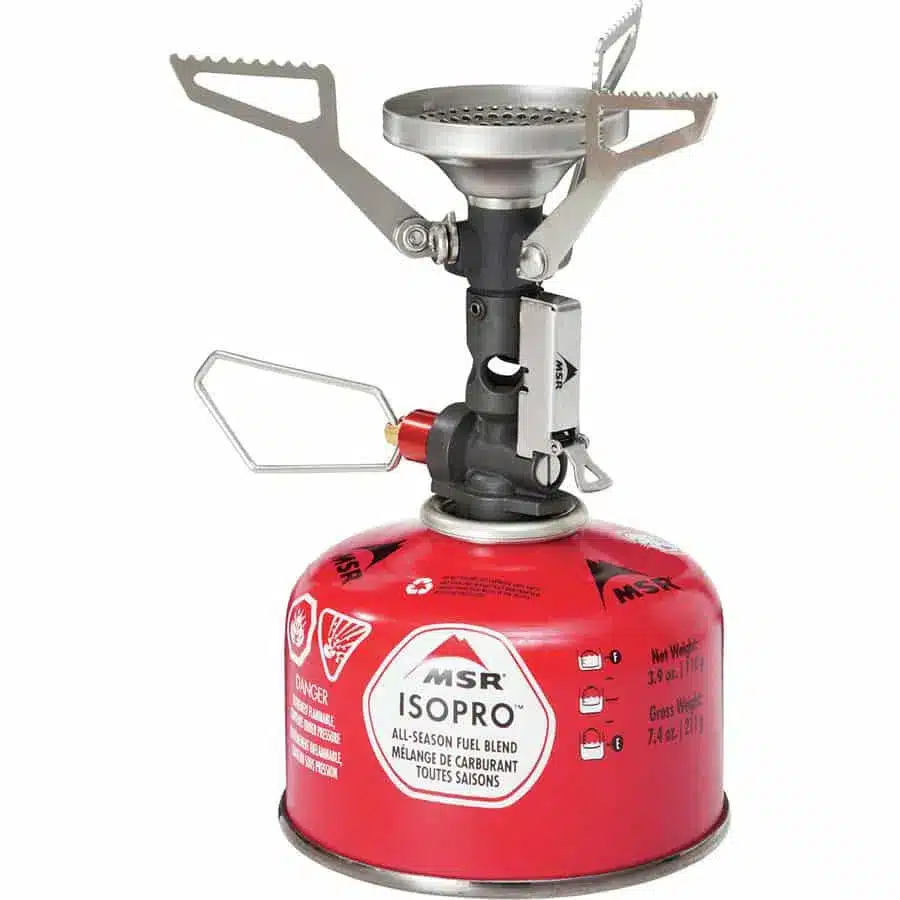Things to See & Do on an Olympic Peninsula Road Trip
The Olympic Peninsula encompasses the northwest corner of Washington state, covering about 3,600 square miles, including Olympic National Park. There’s so much to see – mountain peaks, waterfalls, rainforests, rugged beaches, and more! An Olympic Peninsula road trip is an amazing way to explore this moody, scenic part of the state.
This guide will tell you all the best stops to take, things to see and do, hikes along the way, tips for exploring, and some sample Olympic Peninsula road trip itineraries!
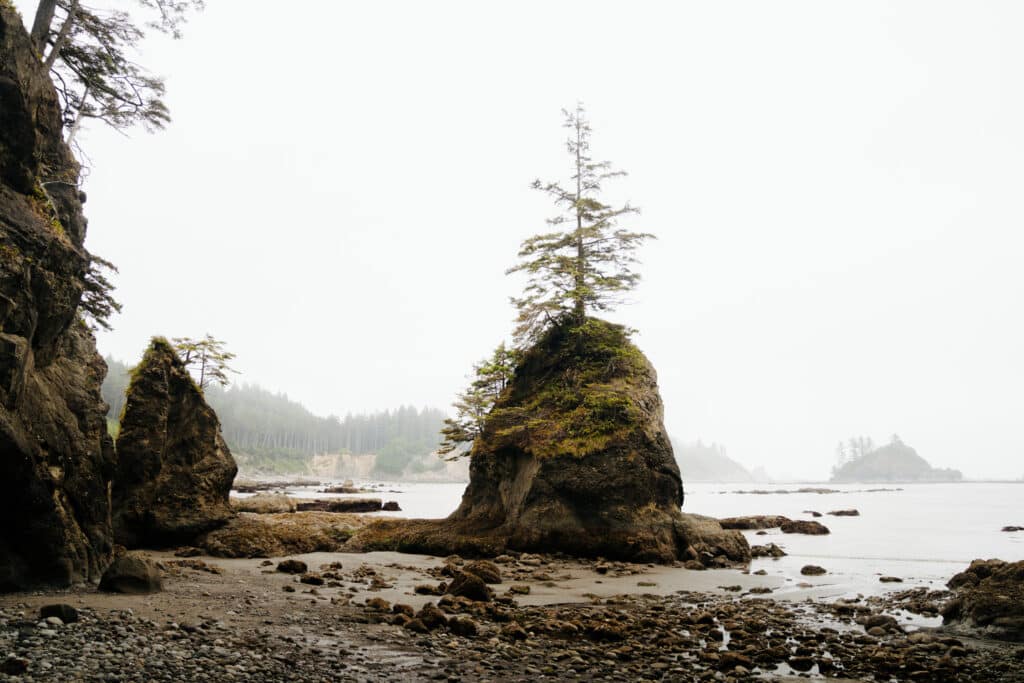
Head’s up: some of these links are affiliate links, so I get a commission if you make a purchase (at no cost to you). But that’s great, because I was going to share anyway, and this helps me keep making free guides for you!

Pin this photo to save this Olympic Peninsula road trip guide and reference it later!
Table of Contents
Land Acknowledgement
Visiting the Olympic Peninsula means recreating on stolen land. There are several tribes that currently live on reservations in this area – Lower Elwha Klallam, Jamestown S’Klallam, Port Gamble S’Klallam, Skokomish, Quinault, Hoh, Quileute, and Makah. I encourage you to learn more by clicking any of those links, and by checking out Native Land to see whose land you’re on.
A portion of any income I make from this post, and this blog as a whole, is donated to various Indigenous Human Rights Organizations or directly to tribes. If you‘d like some examples of places to consider donating, I currently support Indigenous Roots and Real Rent Duwamish.
How to Plan an Olympic Peninsula Road Trip
My favorite tool for road trip planning is The Dyrt. With the free app, you can find campsites and places to stay – and with The Dyrt Pro, you can also create a road trip route and map out your Olympic Peninsula trip!

Getting to the Olympic Peninsula
The best place to begin your Olympic Peninsula road trip is in Seattle. You’ll need a car to get around.
If you’re flying in before your road trip, you’ll land at the SeaTac airport in Seattle. I recommend using Expedia to find the best deals on flights! From there, you can rent a car through Discover Cars or Rental Cars.
But, a great alternative to driving your car or renting one is to travel in a camper van! You’ll get a vehicle and a place to stay, all in one.
With Escape Campervans, you can rent a professionally built, fully decked out van! Another option is to use Outdoorsy, which tends to be more budget friendly. It’s like Airbnb, but for camper vans – you rent a van, trailer, or RV from a person in the area.
From Seattle, you can take a ferry across Puget Sound – you can drive your car onto the ferry and it’ll take you to across (you probably know this if you live in Washington, but I mention it because when I first moved to here from the east coast, I was absolutely mind blown and had no idea ferries like that existed!). The ferry costs around $50 round trip (depending on which terminals you depart from and arrive in and how big your vehicle is – you can check the fares here), but you can also just drive south from Seattle to Olympia, and then make your way north along the Olympic Peninsula!

The Best Time for an Olympic Peninsula Road Trip
One thing you should definitely know about the Olympic Peninsula is that it’s really rainy!
The most popular time to visit is summer, when the area gets a short break from the rain. In the mountains, snow doesn’t completely melt until around mid-July, so if you want to do some high elevation hikes, it’s best to wait for summer.
But, spring and fall can be great times to take a road trip around the Olympic Peninsula if you want to avoid crowds! The coastal regions usually have more mild temperatures, so while you’ll definitely need to be prepared for rain, the weather is usually warm enough to explore and enjoy the scenery – you’re likely to have it to yourself!
Winter is cold and rainy, so while you can definitely enjoy the Olympic Peninsula, you’ll need to bundle up with waterproof layers.
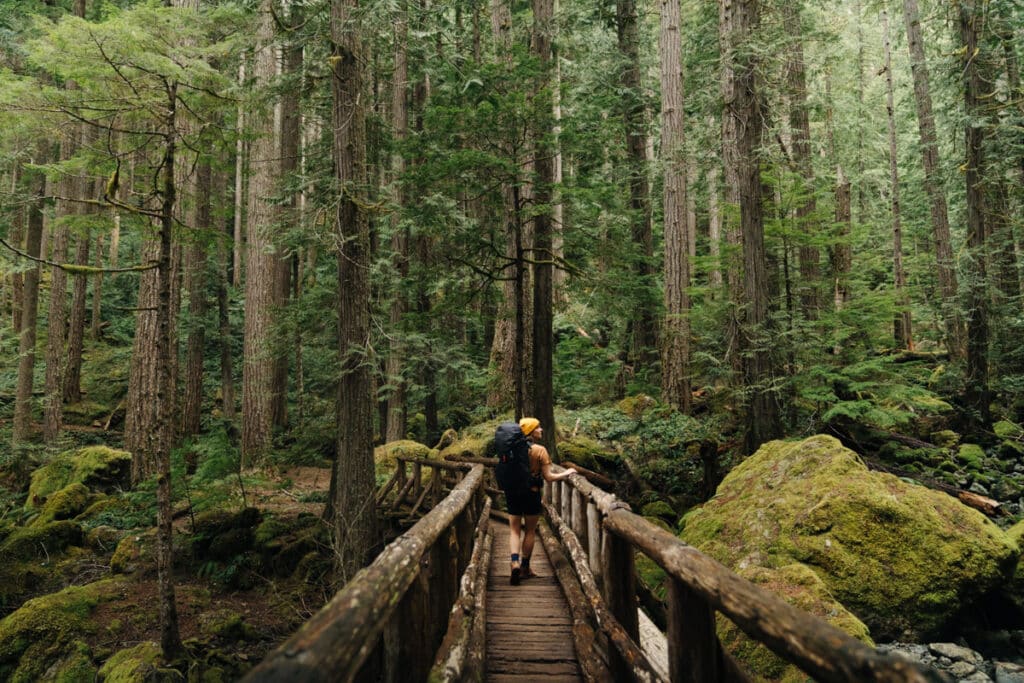
Where to Stay on an Olympic Peninsula Road Trip
During your road trip, you’ll have a few options for places to stay!
Glamping, Cabins, & Yurts
For a unique place to stay during your trip, check out Hipcamp! It’s like Airbnb for campsites – and you can find yurts, cabins, glamping sites, and more.
You can even get $10 off your first booking here!
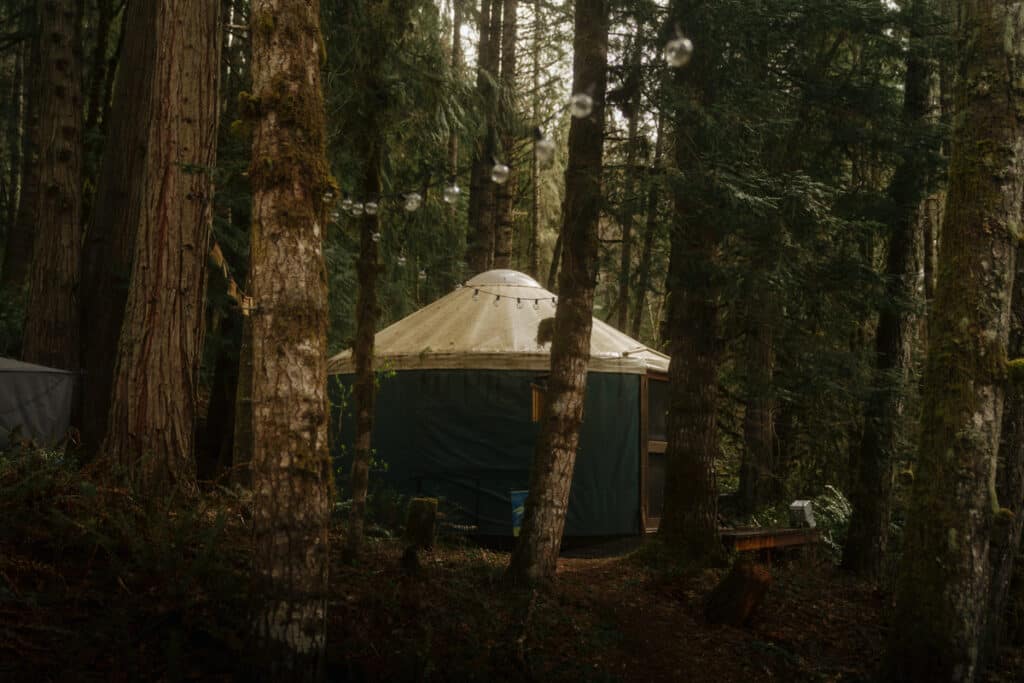
A Camper van
With a camper van, you get a vehicle and a place to sleep, all in one! This is my favorite way to travel, and you can rent a fully decked out van with Escape Campervans. Another option is to use Outdoorsy, which is more like Airbnb – you can rent vans, RVs, and trailers from people who live nearby!

Find a Campsite
Whether you car camp, tent camp, or rent a tiny home on wheels, The Dyrt is the best way to find campsites!
There are lots options for free camping on the Olympic Peninsula – for tips on finding the best ones, check out this guide.

Try the Dirt Pro
Free for 30 days
Find campsites, plan road trips, and see the boundaries of national forest land where you can camp for free!
Hotels, Inns, and Vacation Homes
There are also plenty of hotels and vacation rentals on the Olympic Peninsula – from lakeside lodges to cute cabins.
For more options, check out this map of places to stay. Make sure to change the dates, and zoom out to see all of your options!
Booking.comOlympic Peninsula Road Trip Map
In the next section, I’ll talk about all of the must see spots – but this Olympic Peninsula road trip map will give you an overview!
The hiker icons are hikes (green for easy, yellow for harder ones), and the binoculars are easily accessible overlooks or places to see that don’t require any hiking. The black houses are places to stay!
Must Sees & Stops on Your Olympic Peninsula Road Trip
Now, let’s talk about all the things to see and the best stops on an Olympic Peninsula road trip. These start from the spot closest to Seattle, then taking you north and around the loop – but, you can take this road trip in the other direction, or start anywhere you want!
Lake Cushman
In the southeast portion of the Olympic Peninsula, and just 2 hours from Seattle, is Lake Cushman – sitting at the base of the mountain range, with gorgeous hiking trails, parks, campsites, roadside waterfalls, and more!
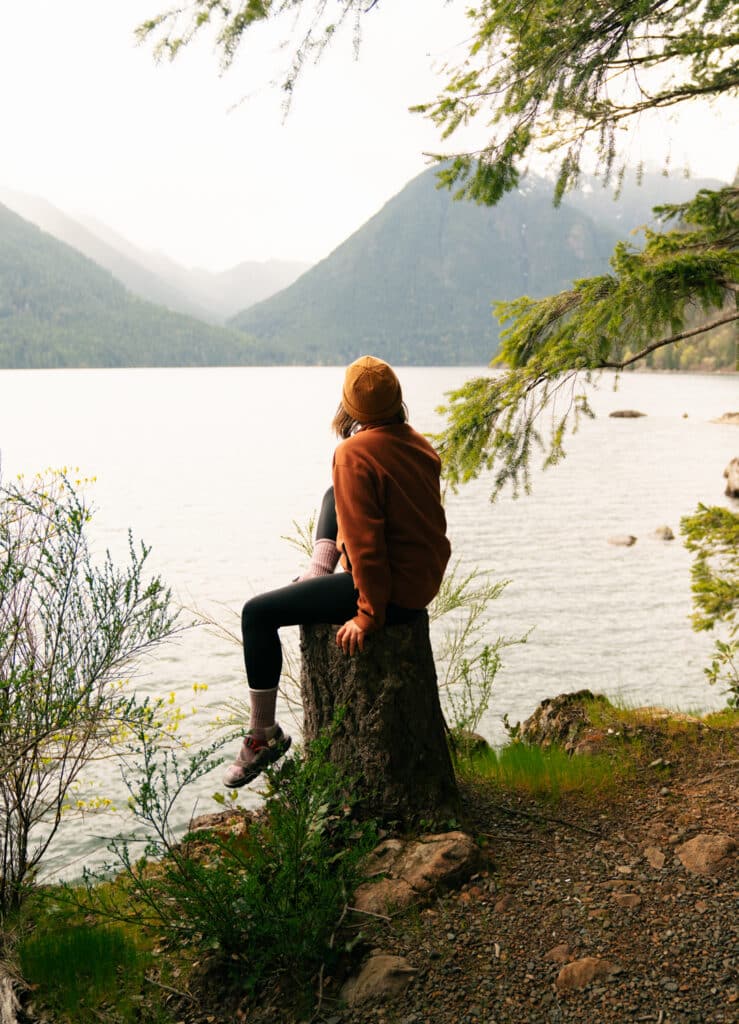

Mount Ellinor Trail
Mount Ellinor is a pretty difficult hike, and unless you have an ice axe and crampons, it’s best to do this one in the summer. The trail is steep, but you’ll be rewarded with incredible views of the ridge line at the summit – plus a mountain goat who tens to hang out at the top!
Distance: 3.1 miles round trip (7 miles if you start at the lower trailhead)
Elevation Gain: 2,342 feet (3,385 if you start at the lower trailhead)
Difficulty: hard
Staircase Rapids Loop
The Staircase Rapids Loop Trail is a short, easy trail – but it’s gorgeous! You’ll go through old growth forests, walk along the rapids, and cross a few creeks. It’s located in Olympic National Park, super close to Lake Cushman.
Distance: 2.1 mile loop
Elevation Gain: 213 feet
Difficulty: easy

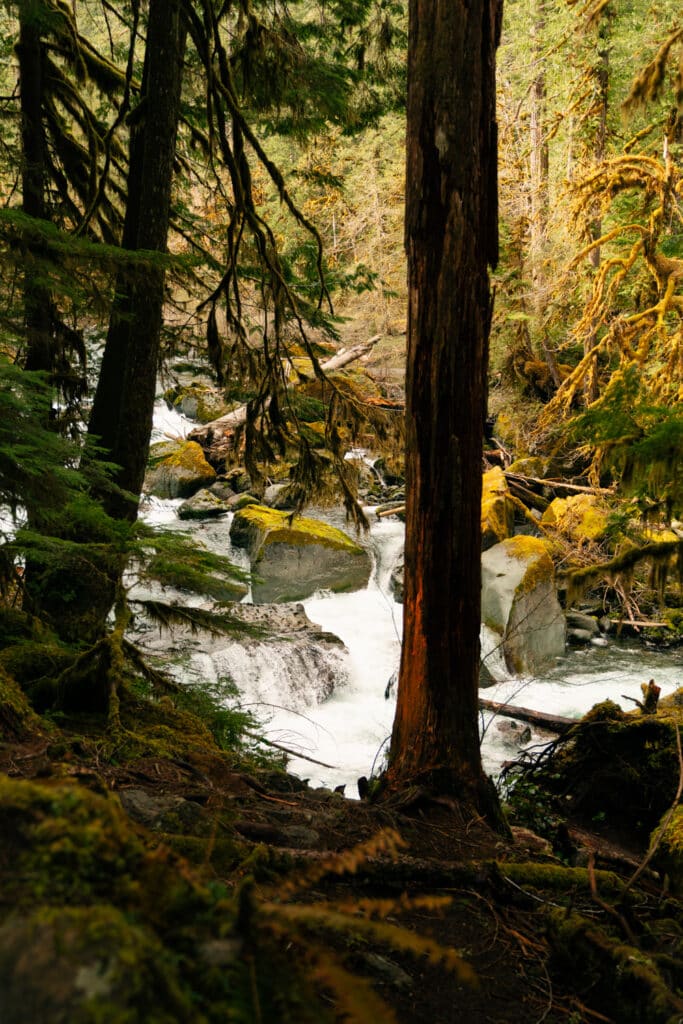
Murhut Falls
The Pacific Northwest has tons of amazing waterfalls – and this trail on Washington’s Olympic Peninsula is a short, easy hike with incredible views! The Murhut Falls trail is a quick out and back hike that will take you to through old growth forests to a dramatic waterfall.
Distance: 1.4 miles round trip
Elevation Gain: 393 feet
Difficulty: easy – moderate
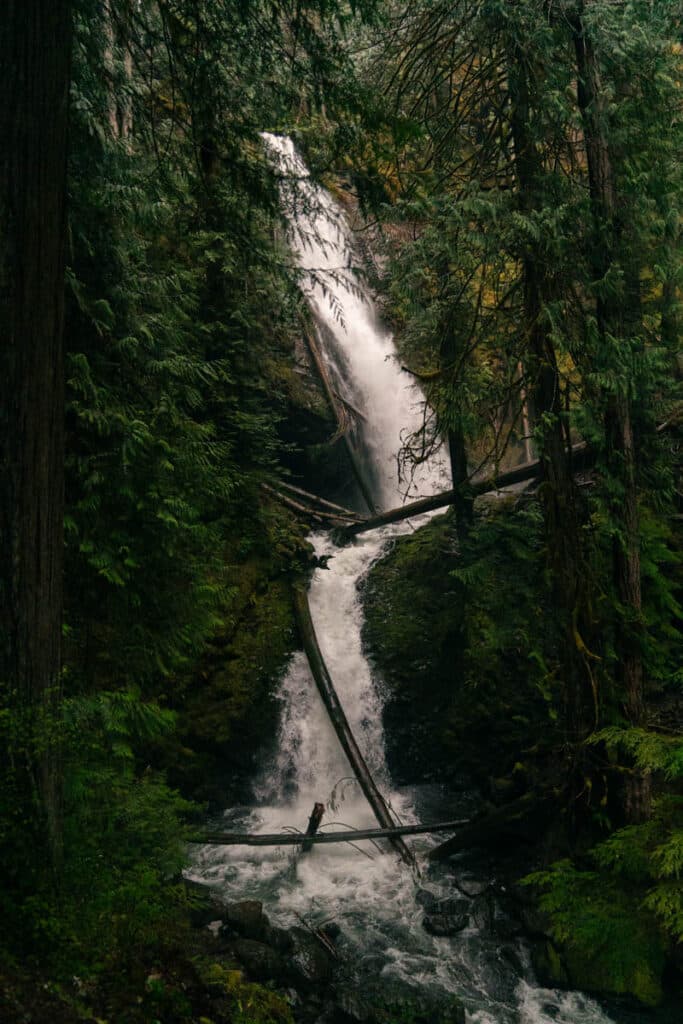

Lower Lena Lake
Washington has lots of amazing alpine lakes, and whether you’re backpacking or looking for a day hike, Lena Lake is a gorgeous spot where you can camp right on the edge of the lake!
You can hike the lower Lena Lake trail, which is located in the Olympic National Forest – this trail ends at the Lena Lake campground, where you can stay for the night. But, you also have the option of continuing to the upper Lena Lake trail, which is in Olympic National Park (dogs aren’t allowed in national park territory). The upper trail is more strenuous, as it’s steeper and less maintained.
Distance: 7 miles round trip
Elevation Gain: 1,630 feet
Difficulty: moderate
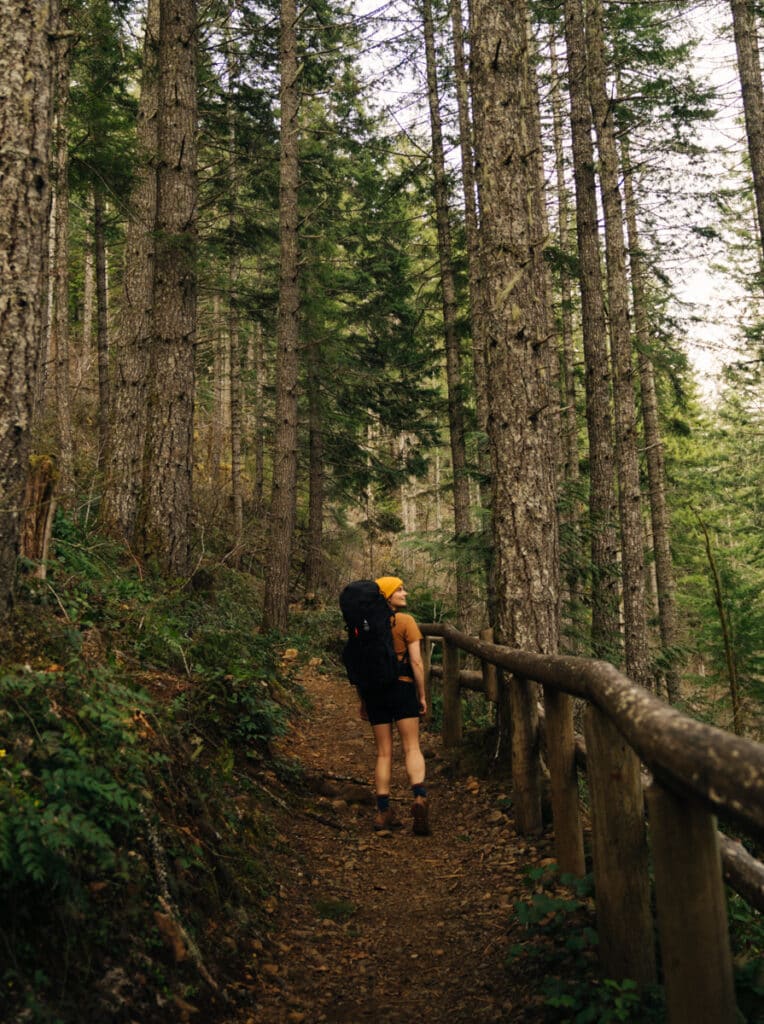
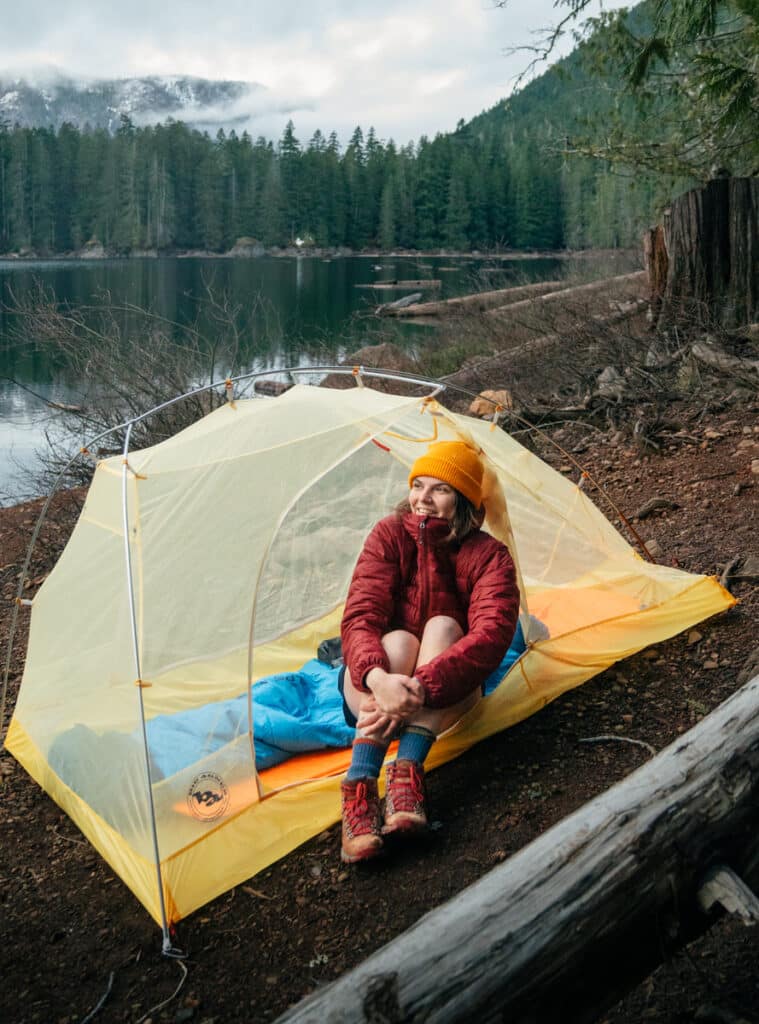
Rocky Brook Falls
Rocky Brook Falls requires just a short walk to reach it, and you’ll be at a beautiful waterfall! There’s even a swimming hole at the bottom of the falls if you want to take a dip.
Lake Angeles
If you’re looking to take the leap from day hikes to overnight trips, the Lake Angeles trail in Olympic National Park is a perfect hike for beginner backpackers! It can easily be done as a day hike, but sleeping under the stars next to the peaceful lake makes the experience even more magical. You’ll walk through the forest, up a steep hillside before emerging to beautiful views of the mountains over the lake!
Length: 8 miles (12.87 km) out and back
Elevation Gain: 2486 feet (758 meters)
Difficulty: Moderate – hard
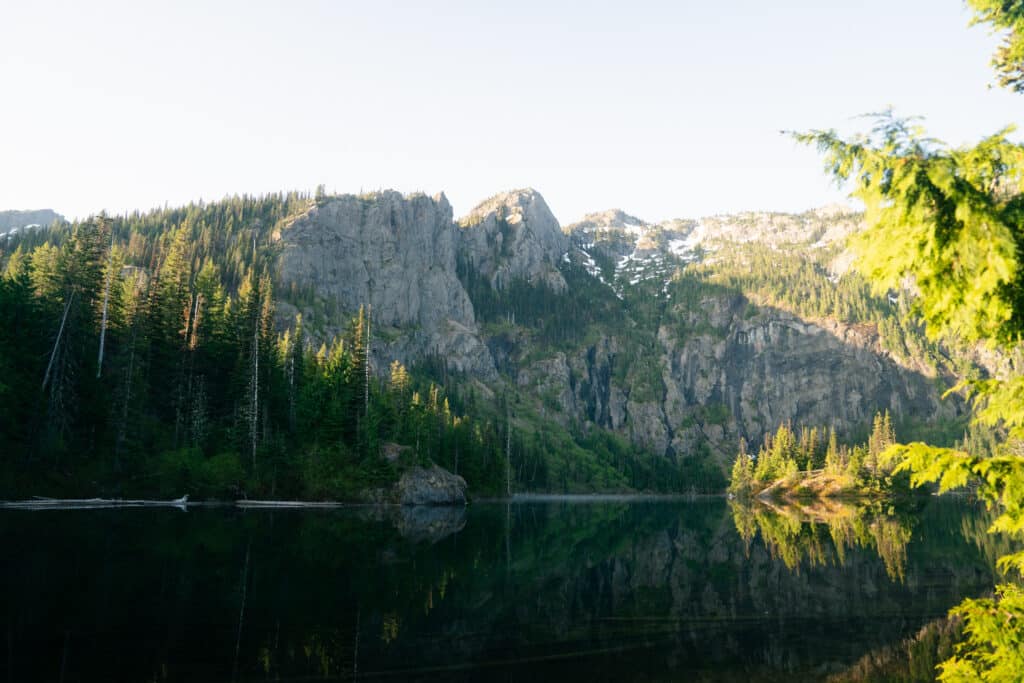
Hurricane Ridge
Hurricane Ridge has some of the best mountain views on the Olympic Peninsula, and you don’t have to hike to see them! The drive up is incredibly scenic, and you get incredible vistas right from the parking lot. But, there are also several trails that begin here, ranging from easy to strenuous hikes. The Hurricane Hill trail is a great shorter hike, and the Klahhane Ridge trail is one of my favorites!

Lake Crescent
Lake Crescent is a gorgeous lake surrounded by mountains, and an incredible place to swim, paddle board, or begin a hike as several trailheads begin here. The Lake Crescent Lodge is right on the shore, making it a great place to stay during your Olympic Peninsula road trip.
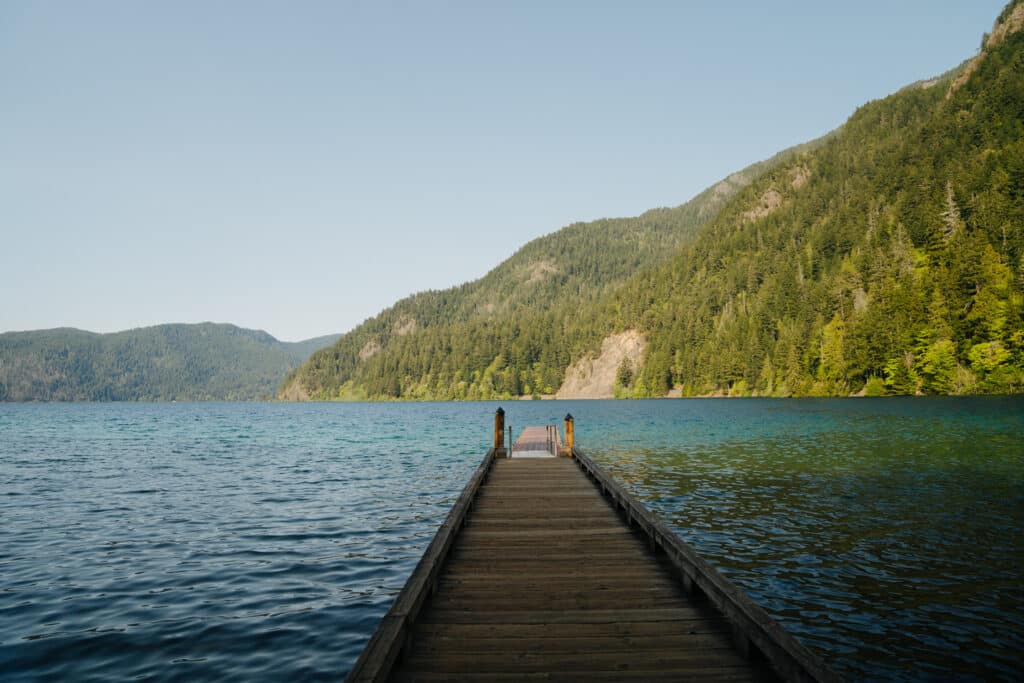
Marymere Falls
Marymere Falls is on the way to Mount Storm King, so if you’re doing that harder hike, it’s a great detour! But even on its own, the waterfall is a beautiful place to hike to. The trail is easy, and pretty flat most of the way – until you get close to the waterfall and have to climb some stairs.
Distance: 1.7 miles (2.74 km) out and back
Elevation Gain: 298 feet (91 m)
Difficulty: easy
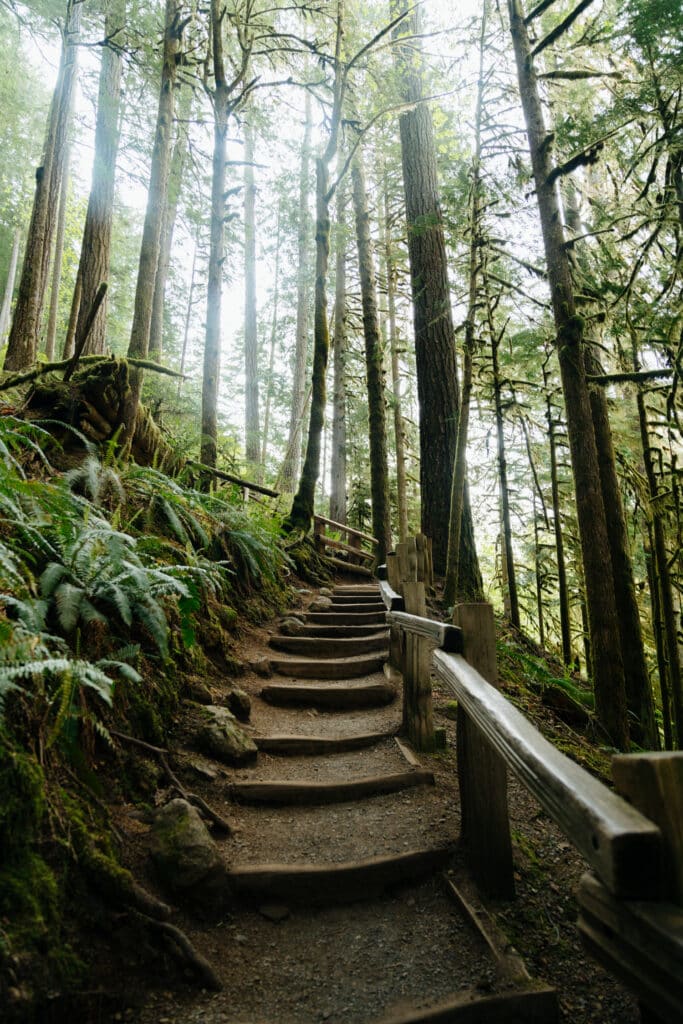
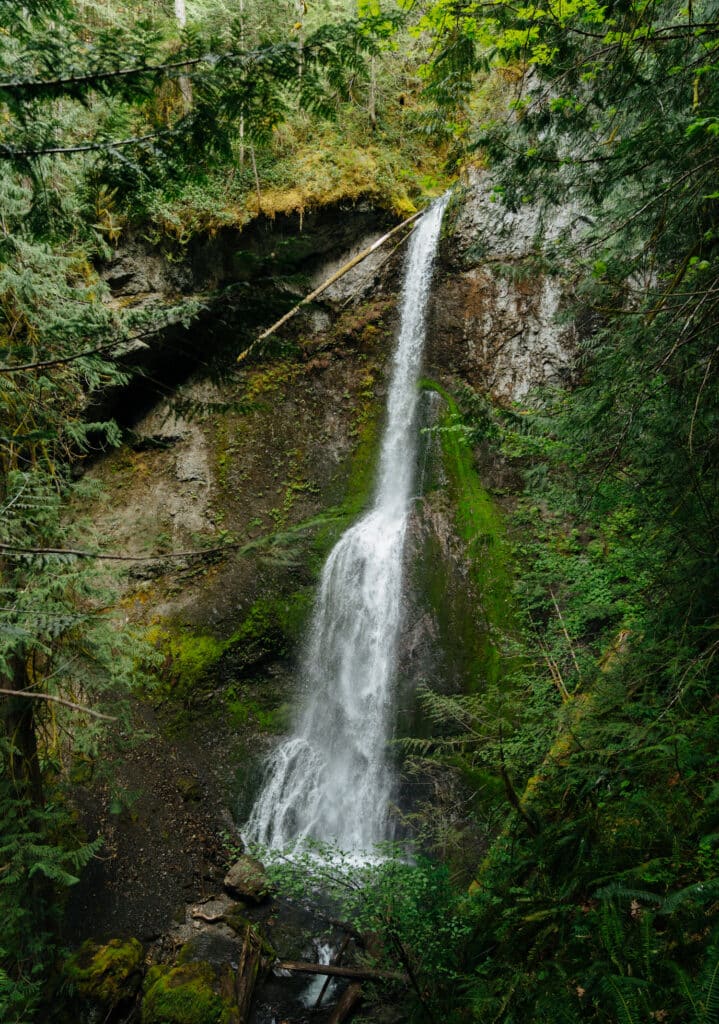
Mount Storm King
Mount Storm King, with it’s ominous name, is definitely a challenge. The peak towers high over Lake Crescent in Olympic National Park, and though the hike isn’t very long, it is very steep – and the best views require a steep scramble and pulling yourself along on ropes! But though it’s a hard hike, it’s manageable, and so worth it.
Length: 4.1 miles (6.6 km) out and back
Elevation Gain: 2106 feet (642 meters)
Difficulty: Hard

Ancient Groves Nature Trail
The Ancient Groves Nature trail is a nice, easy path that takes you through old growth forest. It’s a nice path that will take you less than half an hour to complete, and is great for stretching your legs and spotting different types of birds!
Distance: 0.5 miles (0.8 km) out and back
Elevation Gain: 52 feet (15.85 m)
Difficulty: easy
Sol Duc Falls
Sol Duc Falls is one of the most beautiful waterfalls in Washington – and it’s super easy to get to! The trail is short and flat, but you have the option to extend it and do some other hikes if you want to get deeper into nature, and get away from the crowds a bit.
Distance: 1.6 miles (2.57 km) out and back
Elevation Gain: 226 feet (68.88 m)
Difficulty: easy

Cape Flattery

Cape Flattery is the northwesternmost point of the contiguous United States, and an absolutely beautiful place. The hike is short and easy, taking you to several wooden platforms where you can see the gorgeous rock formations in the ocean.
Distance: 1.2 miles (1.93 km) out and back
Elevation Gain: 229 feet (69.8 m)
Difficulty: easy
Shi Shi Beach
Shi Shi (pronounced shy shy) Beach is a great beginner backpacking trip, or an amazing day hike! The trail is often muddy, so make sure you have trails with good traction. The forested trail will lead you out to the beach, where you can enjoy sea stacks and tide pools.
Distance: 8.8 miles (14.16 km) out and back
Elevation Gain: 561 feet (171 m)
Difficulty: moderate
Rialto Beach
Rialto Beach is beautiful, and you can take a walk down the beach you’ll find even more amazing views! Make sure to do this when the tide is low, because if it’s over 6 feet, the beach will be covered. There’s no official trail here, as you just walk on the sand following the shoreline – while the hike is flat, it can sometimes get a little tiring to walk on soft sand! Still, it’s a great walk to see tide pools, rock formations, and the iconic Hole-in-the-Wall.

Second Beach
Second Beach is one of the most beautiful beaches I’ve ever seen! A short walk through the forest takes you to this beach, with sea stacks, tide pools, and incredible scenery. It’s an amazing place for beach camping too! The hike has a few short inclines, but nothing too strenuous.
Distance: 2.1 miles (3.4 km) out and back
Elevation Gain: 278 feet (85 m)
Difficulty: easy

Third Beach
The hike to Third Beach is a nice walk through the woods that opens up to this gorgeous beach. This is the trailhead for the South Coast Wilderness trail, so if you want to turn this hike into a 17 mile backpacking adventure, this is where you start! But, if you just want a short, easy hike, this is a great trail – and you can also camp on the beach.
Distance: 1.4 miles (2.3 km) out and back
Elevation Gain: 240 feet (73.2 m)
Difficulty: easy

Forks
Forks is a small town on the Olympic Peninsula, best known for being the setting of the Twilight series. It’s full of quirky memorabilia, and you can visit the Twilight museum, see Bella’s truck, and more. Even if you aren’t a fan, there are lots of little shops to explore in Forks!

Hoh Rainforest
Did you know there’s a rainforest right here in Washington? The Hoh Rainforest is a temperate rainforest, with lush greenery all around. There are several amazing trails to explore here – The Hall of Mosses is a nice nature walk where you can see a forest of hanging moss, and if you’re up for a challenge, you can hike the Hoh River Trail to Blue Glacier. Glaciers are what formed this area, and this trail gives you an opportunity to see one!
During the summer, this area gets very busy, so there are often long waits at the entrance – get there early!

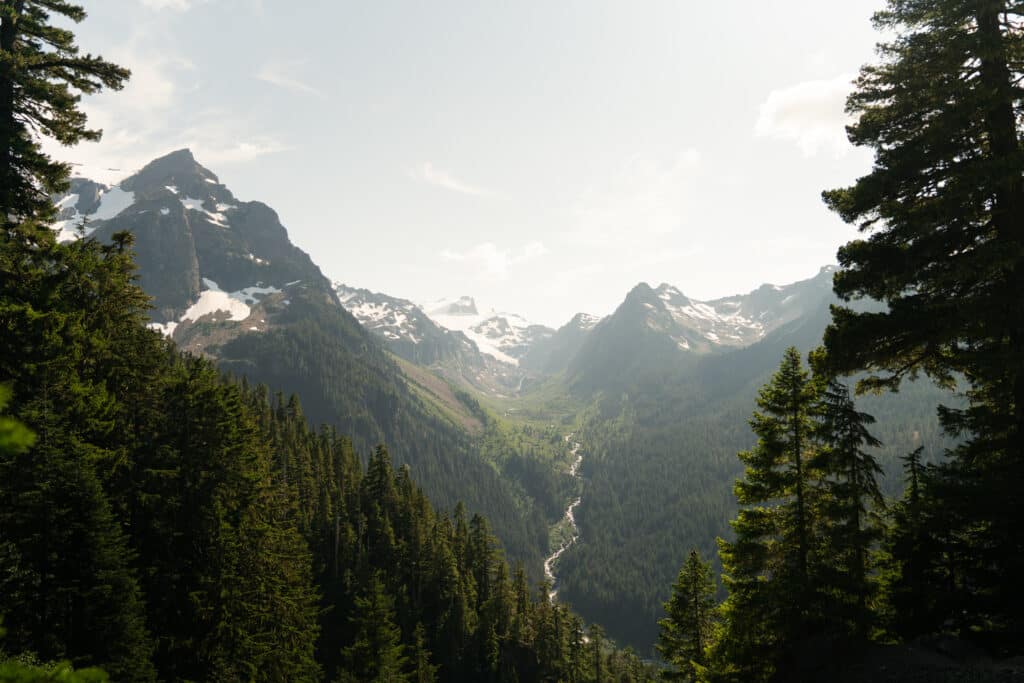
Ruby Beach
Ruby Beach is one of the most popular beaches on the Olympic Peninsula! A short walk takes you down from the parking lot to the beach, where there are towering rock formations, tide pools, and driftwood on the shore. It’s a really beautiful beach, with lots to explore.

Tree of Life
The Tree of Life is a really unique stop on an Olympic Peninsula road trip. This tree has fully exposed roots, and hangs over a cave formed on a coastal bluff. And somehow, it’s thriving! You can see this tree near the Kalaloch Campground, and marvel at how it’s stayed suspended in the air for years.

Quinault Rainforest
The Quinault Rainforest is less popular than the Hoh Rainforest, so you can see similar scenery here without as many crowds, and without the long wait times. It’s a great place to explore a temperate rainforest and do some hiking. One of the best trails in the area is the Quinault Loop, taking you along the lake and through the greenery!

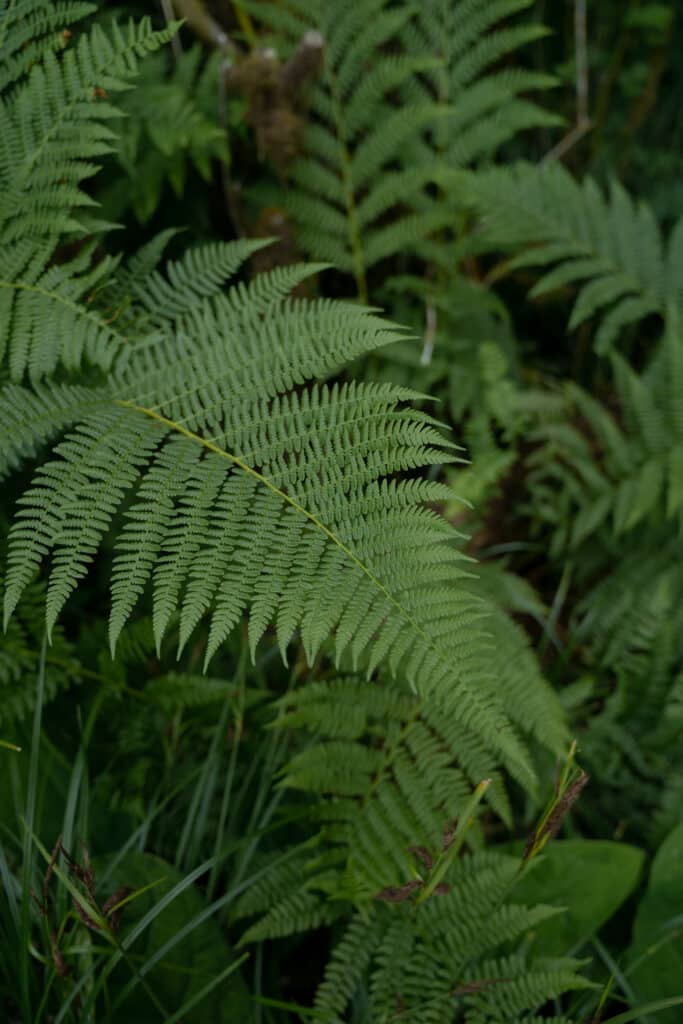
Olympic Peninsula Road Trip Itinerary
To help you plan, here are a few sample Olympic Peninsula road trip itineraries!
3 Day Olympic Peninsula Road Trip Itinerary
If you only have three days to explore, you can still see quite a bit of the area! Here’s a sample 3 day Olympic Peninsula road trip itinerary:
Day 1
- If you’re starting in Seattle, I recommend starting your road trip early to make the most of your day! I recommend taking the ferry from Edmonds to Kingston, then keep driving to Hurricane Ridge.
- Explore Hurricane Ridge – there are several longer hikes that start here, but you can also take some short walks around the area, and the views are amazing right from the parking lot.
- Spend the night at the Lake Crescent Lodge
Day 2
- If you stayed at the Lake Crescent Lodge, you’ll wake up right by the lake!
- I recommend hiking the Mount Storm King trail – it’s one of the most beautiful hikes, and will give you an incredible view of the lake. If you aren’t feeling up for a hard hike, you can also rent kayaks and explore the lake instead!
- Next, head to Sol Duc Falls and take a short walk to the waterfall
- Stay at Sol Duc Den, a tiny cabin near Forks.

Day 3
- Spend some time exploring the quirky town of Forks
- Head to La Push to enjoy sunset at the beach! If you’re up for a short hike, visit Second Beach – but if you prefer something easily accessible, head to First Beach!
5 Day Olympic Peninsula Road Trip Itinerary
Here is a sample 5 day Olympic Peninsula road trip itinerary:
Day 1
- If you’re starting in Seattle, I recommend starting your road trip early to make the most of your day! I recommend taking the ferry form Edmonds to Kingston, then keep driving to Hurricane Ridge.
- Explore Hurricane Ridge – there are several longer hikes that start here, but you can also take some short walks around the area, and the views are amazing right from the parking lot.
- Spend the night at the Lake Crescent Lodge
Day 2
- If you stayed at the Lake Crescent Lodge, you’ll wake up right by the lake!
- I recommend hiking the Mount Storm King trail – it’s one of the most beautiful hikes, and will give you an incredible view of the lake. If you aren’t feeling up for a hard hike, you can also rent kayaks and explore the lake instead!
- Next, head to Sol Duc Falls and take a short walk to the waterfall
- Stay at Sol Duc Den, a tiny cabin near Forks.
Day 3
- Spend the day exploring the town of Forks, and if you want to see some beaches, check out La Push.
- Drive up to Cape Flattery for sunset – the short trail is really stunning, and you’ll find yourself at the northwesternmost point of the contiguous United States.
- Return to Sol Duc Den for the night.
Day 4
- Drive to the Hoh Rainforest, and walk the short Hall of Mosses trail, then the Spruce Nature trail. Make sure to start early, as there’s often a line to the parking lot!
- From there, drive to Ruby Beach and enjoy the views.
- Stop at the Kalaloch Tree of Life before heading to a cozy cottage for the night.
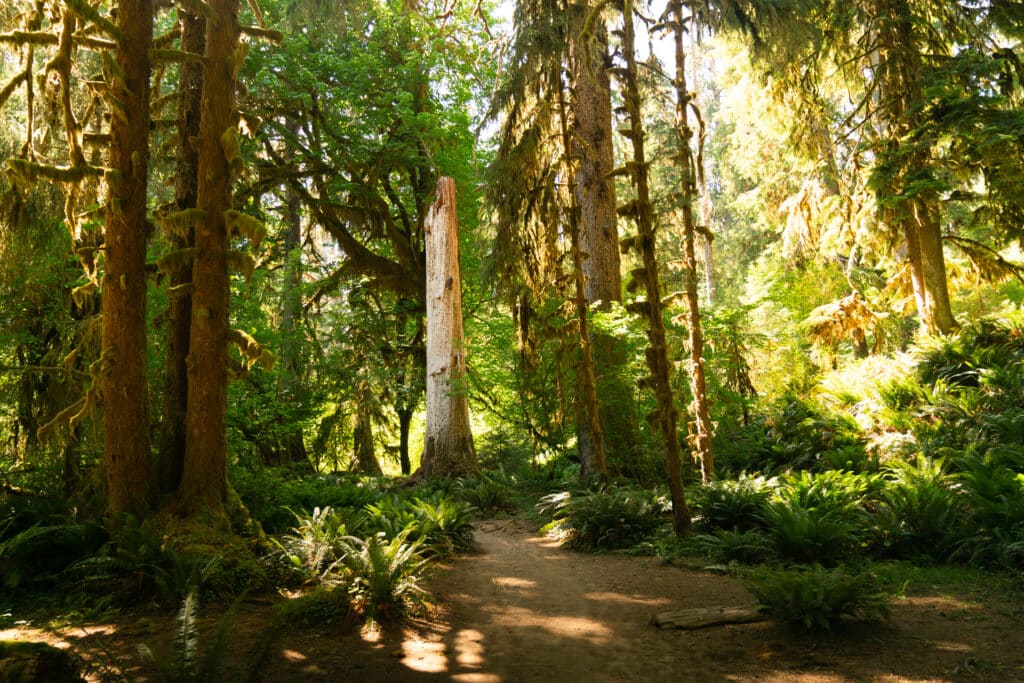
Day 5
- Head to the Quinault Rainforest and hike the Quinault Loop.
- Rent kayaks and get out on the lake.
- Stay at the Lake Quinault Lodge, or head back to Seattle!
7 Day Olympic Peninsula Road Trip Itinerary
A week is a great amount of time to spend exploring, as it gives you more time for hikes! Here’s a sample 7 day Olympic Peninsula road trip itinerary.
Day 1
- If you’re starting in Seattle, I recommend starting your road trip early to make the most of your day! I recommend taking the ferry form Edmonds to Kingston, then keep driving to Hurricane Ridge.
- Explore Hurricane Ridge – there are several longer hikes that start here, but you can also take some short walks around the area, and the views are amazing right from the parking lot.
- Spend the night at the Lake Crescent Lodge
Day 2
- If you stayed at the Lake Crescent Lodge, you’ll wake up right by the lake!
- I recommend hiking the Mount Storm King trail – it’s one of the most beautiful hikes, and will give you an incredible view of the lake. If you aren’t feeling up for a hard hike, you can also rent kayaks and explore the lake instead!
- Next, head to Sol Duc Falls and take a short walk to the waterfall
- Stay at Sol Duc Den, a tiny cabin near Forks.
Day 3
- Go backpacking and spend a night at Shi Shi Beach!
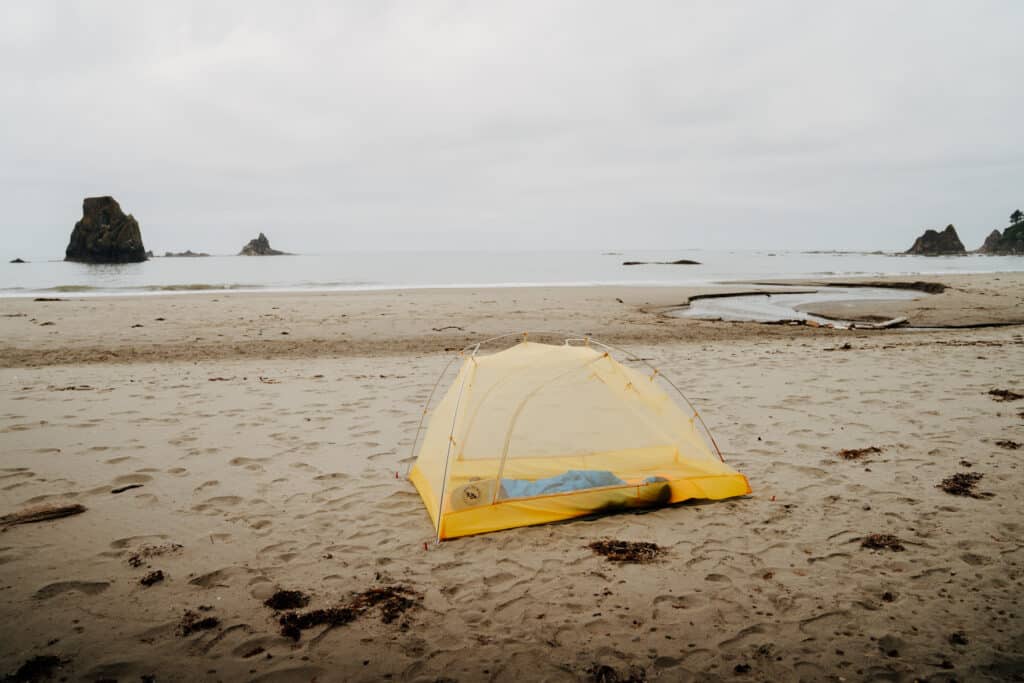
Day 4
- Wake up on the beach, then head to Cape Flattery. Take the short walk to the northwesternmost point of the contiguous United States.
- Drive back to Forks, and spend the day exploring the town. and if you want to see some beaches, check out La Push.
- Return to Sol Duc Den for the night.
Day 5
- Drive to the Hoh Rainforest, and walk the short Hall of Mosses trail, then the Spruce Nature trail. Make sure to start early, as there’s often a line to the parking lot!
- From there, drive to Ruby Beach and enjoy the views.
- Stop at the Kalaloch Tree of Life before heading to a cozy cottage for the night.
Day 6
- Drive to Lake Cushman, and hike the short Staircase Rapids Nature Trail.
- Explore Lake Cushman – go cliff jump or kayak on the lake!
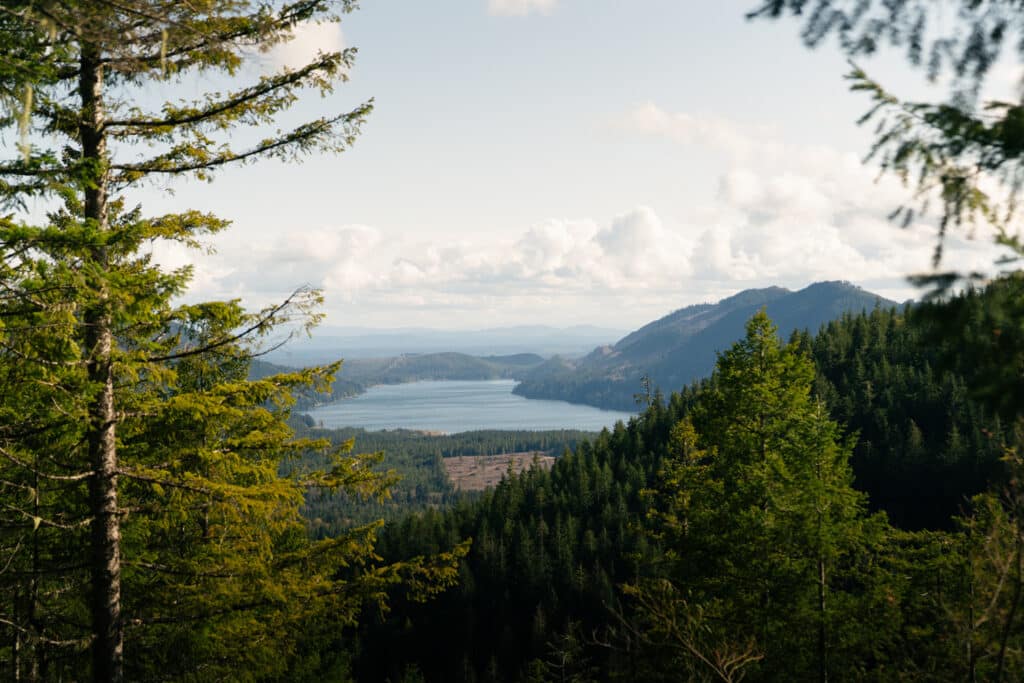
Day 7
- Hike the Mount Ellinor trail before heading back to Seattle.
What to Bring for an Olympic Peninsula Road Trip
To help you pack for your Olympic Peninsula road trip, here are some essentials to bring with you!
Waterproof Shoes
Waterproof shoes are a must if you’re planning on hiking or exploring, because the Olympic Peninsula is rainy for so much of the year – even if you get some sunny days, the trails are likely to be muddy. Even if you aren’t hiking, I recommend waterproof shoes for any scenic stops along the Olympic Peninsula.
My favorite hiking boots are my Danner boots – they’re cute, comfortable, and waterproof! I also love hiking in my Chacos, and they’re also amazing for exploring the beaches. Rain boots are another great option for muddy conditions, and are definitely the easiest to clean.
Bonus Tip: A lot of these links are for my favorite place to buy outdoor gear – Backcountry. If you install the free Lolli extension on your browser, you can earn free Bitcoin when you shop online at certain retailers, including Backcountry. Download Lolli here!
Rain Gear & Layers
The Olympic Peninsula is known for moody weather. It rains often, but even if rain isn’t in the forecast, I recommend bringing a windbreaker any time you’re going to be by the water. Even in the summer, the ocean “breeze” is more like a strong wind, and even on a sunny day you’ll get chilly fast!
The Marmot Minimalist Jacket is a great lightweight, waterproof option for rain. For windbreakers, the RVCA Meyer Packable Anorack Jacket is cute, and folds up nice and small! For added warmth and layering, add a a Patagonia fleece.
Backpack
You need somewhere to put your snacks! And your hiking gear, of course.
When I’m bringing my camera gear, my favorite backpack is the Alex Strohl Mountain Light. It’s definitely the best camera bag out there for hiking with photo gear. If you don’t need storage for camera stuff, I recommend an Osprey Hikelite. If you aren’t planning any intense or long hikes, I love my Topo Designs Y-Pack for carrying everyday essentials!
Hydration!
Especially when you’re hiking or exploring outdoors, it’s important to stay hydrated! Single use water bottles are, of course, terrible for the environment, so avoid that and bring a reusable one!
For hiking, the CamelBak water reservoirs are convenient and easy – they can fit in your hiking backpack for water on the go. Nalgene water bottles are great for day to day, and if you want an insulated water bottle to keep your water cold and refreshing, Hydro Flasks are the best!
Tent
You can stay in hotels or Airbnbs throughout your Olympic Peninsula road trip – but there are also tons of campsites that make for a cheap (or free), scenic place to sleep!
If you want to camp, you may need a tent. The Stoic Madrone 2 person tent is a more budget friendly option. If you backpack, you may want to invest in a lighter tent – the Big Agnes Tiger Wall tent weighs less than 2 pounds!
If you’re traveling alone, I really recommend trying out hammock camping! Sleeping in a hammock is incredibly comfortable – you’ll never go back to a tent. The ENO hammocks are definitely the best, and you can get a rain cover as well. Though I wouldn’t sleep in a hammock with two people, the double nested hammocks are comfier, and if you sleep in it, it’s big enough to wrap around and protect you from bugs.
Sleeping Pad
Whether you plan to car camp or tent camp, a sleeping pad is a necessity for comfy nights! It takes up much less space than an inflatable mattress, but can help just as much with comfort on the road.
The ALPS Mountaineering Velocity Air Bed is comfortable and great for car camping, and big enough for two. For a lightweight option, the NEMO equipment Switchback Sleeping Pad folds up small and is also great for backpacking! If you’re going to be car camping or backpacking in colder weather, the NEMO Insulated Sleeping Pad is another great, lightweight option.
Camping Stove
When you’re on your Olympic Peninsula road trip (or any other road trip), having a camping stove makes all the difference – you can make your morning coffee, or cook a hot meal at a gorgeous overlook.
Coleman makes the best camping stoves. For smaller, more packable options (good for backpackers), check out the MSR Pocket Rocket stove. A camp cooking set that’s small and easily packable is a great addition to any camp kitchen!
More Adventures After your Olympic Peninsula Road Trip
Have you visited the Olympic Peninsula, or have any recommendations for things to check out nearby? Let me know in a comment below!
Make sure to read this guide about the best hikes in Olympic National Park, or check out Scenic Hot Springs and Gem Lake for more adventures in Washington.
Pin any of these photos to reference this Olympic Peninsula road trip guide later!

